I am new to Spring Security and Oauth2. In my spring boot application, I have implemented authentication with Oauth2 with following set of changes:
Custom Ouath2 User service is as follows:
@Component
public class CustomOAuth2UserService extends DefaultOAuth2UserService {
private UserRepository userRepository;
@Autowired
public void setUserRepository(UserRepository userRepository) {
this.userRepository = userRepository;
}
public OAuth2User loadUser(OAuth2UserRequest userRequest) throws OAuth2AuthenticationException {
...
}
}
Security Configuration is as follows:
@EnableWebSecurity
@Import(SecurityProblemSupport.class)
@ConditionalOnProperty(
value = "myapp.authentication.type",
havingValue = "oauth",
matchIfMissing = true
)
public class SecurityConfiguration extends WebSecurityConfigurerAdapter {
private final CustomOAuth2UserService customOAuth2UserService;
public SecurityConfiguration(CustomOAuth2UserService customOAuth2UserService) {
this.customOAuth2UserService = customOAuth2UserService;
}
@Override
public void configure(WebSecurity web) {
web.ignoring()
.antMatchers(HttpMethod.OPTIONS, "/**")
.antMatchers("/app/**/*.{js,html}")
.antMatchers("/bundle.js")
.antMatchers("/slds-icons/**")
.antMatchers("/assets/**")
.antMatchers("/i18n/**")
.antMatchers("/content/**")
.antMatchers("/swagger-ui/**")
.antMatchers("/swagger-resources")
.antMatchers("/v2/api-docs")
.antMatchers("/api/redirectToHome")
.antMatchers("/test/**");
}
public void configure(HttpSecurity http) throws Exception {
RequestMatcher csrfRequestMatcher = new RequestMatcher() {
private RegexRequestMatcher requestMatcher =
new RegexRequestMatcher("/api/", null);
@Override
public boolean matches(HttpServletRequest request) {
return requestMatcher.matches(request);
}
};
http.csrf()
.requireCsrfProtectionMatcher(csrfRequestMatcher)
.and()
.authorizeRequests()
.antMatchers("/login**").permitAll()
.antMatchers("/manage/**").permitAll()
.antMatchers("/api/auth-info").permitAll()
.antMatchers("/api/**").authenticated()
.antMatchers("/management/health").permitAll()
.antMatchers("/management/info").permitAll()
.antMatchers("/management/prometheus").permitAll()
.antMatchers("/management/**").hasAuthority(AuthoritiesConstants.ADMIN)
.anyRequest().authenticated()//.and().oauth2ResourceServer().jwt()
.and()
.oauth2Login()
.redirectionEndpoint()
.baseUri("/oauth2**")
.and()
.failureUrl("/api/redirectToHome")
.userInfoEndpoint().userService(oauth2UserService())
;
http.cors().disable();
}
private OAuth2UserService<OAuth2UserRequest, OAuth2User> oauth2UserService() {
return customOAuth2UserService;
}
}
Content of application.properties is as follows:
spring.security.oauth2.client.registration.keycloak.client-id=abcd
spring.security.oauth2.client.registration.keycloak.client-name=Auth Server
spring.security.oauth2.client.registration.keycloak.scope=api
spring.security.oauth2.client.registration.keycloak.provider=keycloak
spring.security.oauth2.client.registration.keycloak.client-authentication-method=basic
spring.security.oauth2.client.registration.keycloak.authorization-grant-type=authorization_code
myapp.oauth2.path=https://internal.authprovider.com/oauth2/
spring.security.oauth2.client.provider.keycloak.token-uri=${myapp.oauth2.path}token
spring.security.oauth2.client.provider.keycloak.authorization-uri=${myapp.oauth2.path}authorize
spring.security.oauth2.client.provider.keycloak.user-info-uri=${myapp.oauth2.path}userinfo
spring.security.oauth2.client.provider.keycloak.user-name-attribute=name
myapp.authentication.type=oauth
Now, with the existing authentication mechanism, I would like to add support for multiple authentication providers: LDAP, Form-Login, etc.
In this regard, I have gone through a few articles:
- https://www.baeldung.com/spring-security-multiple-auth-providers
- Custom Authentication provider with Spring Security and Java Config
But, I am not getting any concrete idea regarding what changes should I do in the existing code base in order to achieve this.
Could anyone please help here? Thanks.

